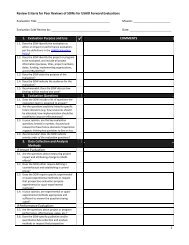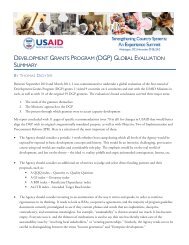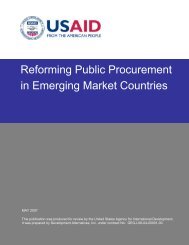Study on USAID Non-Project Assistance Programs in
Study on USAID Non-Project Assistance Programs in
Study on USAID Non-Project Assistance Programs in
Create successful ePaper yourself
Turn your PDF publications into a flip-book with our unique Google optimized e-Paper software.
The first task before NPA designers, then, is to identify those policies for which there is a highdegree of <strong>in</strong>terest and support with<strong>in</strong> the exist<strong>in</strong>g <strong>in</strong>stituti<strong>on</strong>al framework (i.e. "ownership"). The sec<strong>on</strong>dtask is to identify the exist<strong>in</strong>g c<strong>on</strong>stra<strong>in</strong>ts to their adopti<strong>on</strong> and/or implementati<strong>on</strong>. If it is possible toidentify these c<strong>on</strong>stra<strong>in</strong>ts, then NPA (at its best) may be seen as a mechanism capable of perform<strong>in</strong>g twoservices:Facilitati<strong>on</strong> of broad-based discussi<strong>on</strong> around those c<strong>on</strong>stra<strong>in</strong>ts and the strategiesto overcome them.Provisi<strong>on</strong> of resources <strong>in</strong> a timely manner to assist <strong>in</strong> the implementati<strong>on</strong> of theidentified strategies aimed at overcom<strong>in</strong>g the recognized c<strong>on</strong>stra<strong>in</strong>ts (i.e. moretarget<strong>in</strong>g of NPA resources to specific activities).Instead, the NPA experiences that were exam<strong>in</strong>ed appear to have attempted to def<strong>in</strong>e notc<strong>on</strong>stra<strong>in</strong>ts to policy reform, but the process for reform and even the new policies which must be adopted.By do<strong>in</strong>g so, designers may have (<strong>in</strong>advertently) imposed either processes or soluti<strong>on</strong>s that preclude"ownership" and, therefore, implementati<strong>on</strong>.Can NPA satisfy its two objectives of sector policy reform and f<strong>in</strong>ancial impact? Must these twoobjectives be l<strong>in</strong>ked?The allure of NPA is quite seductive <strong>in</strong> its promise of high impact <strong>in</strong> return for relatively smallamounts of m<strong>on</strong>ey and a "light" management burden up<strong>on</strong> the Missi<strong>on</strong>. Given such expectati<strong>on</strong>s, is itpossible to succeed when the complexity of the task at hand is understood? Both NPA objectives ofsupport to policy reform and f<strong>in</strong>ancial impact are justifiable. L<strong>in</strong>k<strong>in</strong>g the two together, however, may notbe the most effective mechanism to accomplish either. The experiences described <strong>in</strong> this paper <strong>in</strong>dicatethat the l<strong>in</strong>kage has not worked effectively. The policy review and reform process may not (despite anyof the rati<strong>on</strong>ales provided about offsett<strong>in</strong>g implementati<strong>on</strong> costs, etc.) resp<strong>on</strong>d to f<strong>in</strong>ancial <strong>in</strong>centives asc<strong>on</strong>ta<strong>in</strong>ed with<strong>in</strong> the NPA framework.NPA has been a participant <strong>in</strong> significant health policy reform efforts <strong>in</strong> both Niger and Kenya(NPA <strong>in</strong> Nigeria merely paid for the implementati<strong>on</strong> of adopted reforms, an alternative model worthc<strong>on</strong>siderati<strong>on</strong>). It is questi<strong>on</strong>able as to whether it has actually driven or leveraged the process <strong>in</strong> eitherNiger or Kenya (as opposed to support<strong>in</strong>g the process). It has kept reform <strong>on</strong> the agenda with<strong>in</strong> a chang<strong>in</strong>gpolitical envir<strong>on</strong>ment.34







